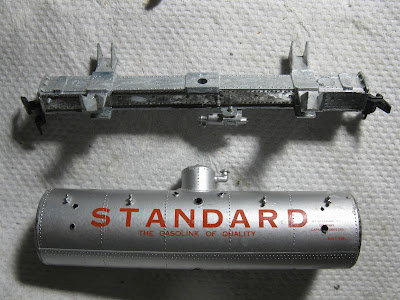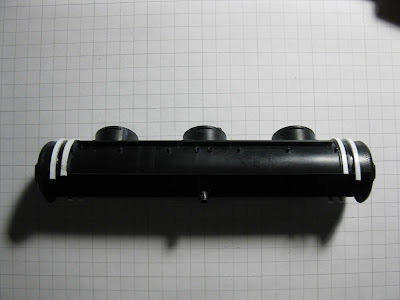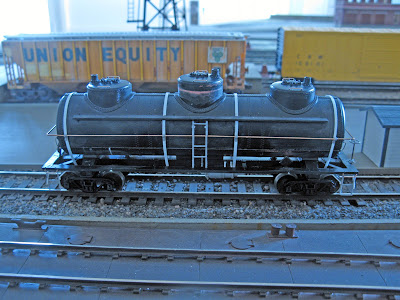Designing a
layout oriented toward train operations like Monk Subdivision requires at
first knowing the nature of movements on the line. Not only the type of trains,
but also where they perform their key actions before and after entering
staging. In that regard, this is not something I’ve done a lot in the past with
previous layouts. I once recall making grand schemes of operation for the first
iteration of CN Murray Bay Subdivision in the 1950s, but it never was applied
and it would be hard to say I had any substantial grasp of what I was trying to
achieve back then... Let's just say that I tried.
Running
adequately Monk Subdivision comes with a big technical issue that must be
answered: staging. At first, it’s all about Where, then it evolves toward How
much until finally reaching the fundamental question of Why? Why do we need
staging, what do we expect from it? Simple storage? A place to fiddle with
trains? A mean to orchestrate train movements? It’s all that, and it needs to
be balanced.
First
question is to determine how many trains and what types of trains are required.
I looked at a few timetables from the 1950s concerning Armagh and Glendyne
subdivisions (later, in 1963 they were merged and renamed Monk subdivision). On
each subdivision, about 14 trains per day were scheduled, not including extras
and other unscheduled movements. This is quite substantial. For the layout purpose, let say all these trains moves between Joffre Yard – Monk Yard – Edmundston Yard. Joffre and Edmundston being staged and Monk being modelled.
Of these 14
trains, two were passenger trains (1 per day), one way freight, four 4th
class freights and eight manifest trains. Let’s break them down and please bear
in mind I’m simplifying and dumbing it down for a small layout. In no way it is my intention to replicate real train movements with a dispatcher. I'm only trying to get a grasp of what happened there in the 1950s.
For this exercise, I'll reuse some concept implemented in softwares such as RocRail and JMRI Operations. Mainly, you start by creating a track plan (which is already done), then add trains and later attribute them certain routes and schedules.
Trains
I compiled a simple table with all the type of trains I could identify in old timetables, including their type, quantity, length and type of staging (more about that later).
|
Track
|
Length (in)
|
Length (ft)
|
Capacity (40’ car)
|
Trains
|
|
Hidden 1
|
200”
|
16.7’
|
33
|
700 + 400 (Edmundston)
|
|
Hidden 2
|
186”
|
15.5’
|
31
|
700 + 400 (Joffre)
|
|
Hidden 3
|
182”
|
15’
|
30
|
51-54 + 67-70 (Edmundston)
|
|
Hidden 4
|
182”
|
15’
|
30
|
51-54 + 67-70 (Joffre)
|
|
Fiddle 1
|
60”
|
5’
|
10
|
Way Freight
(Edmunston)
|
|
Fiddle 2
|
60”
|
5’
|
10
|
Wat Freight (Joffre)
|
|
Fiddle 3
|
60”
|
5’
|
10
|
Switcher Joffre
|
|
Fiddle 4
|
60”
|
5’
|
10
|
QCR 160-161
|
|
Fiddle 5
|
60”
|
5’
|
10
|
QCR Way Freight
|
Trains 67-70
were a pooled service between Montréal, Quebec City and Edmundston. One day, it
ran eastward during the night to Edmundston and the next day, it would go back
to Montréal. It had 5 passenger cars including a coach, two buffet parlours and
two sleepers. We have no indication about the head-end equipment, but we can
safely assume a RPO, a baggage and an express reefer would have been plausible.
In HO, such a consist would be about almost 8ft long. To be noted, the train
would usually stop for almost an hour in Monk, indicating a crew and locomotive
change occurred. I would employ large IHC/Mehano passenger steam locomotive
such as 4-6-4 and 4-8-2 and my TLT 4-8-4 to pull theses heavy trains.
Trains 51-54
were passenger trains operating on days when 67-70 weren’t running. Between
Québec City and Edmundston, starting in the mid-1950s, it was a railiner (Budd
RDC) service while between Edmundston and Moncton, it was a train made of a few
coaches only. Given I’m interested in modelling these trains in the early 1950s
when they were pulled by steam, such a typical consist would be about 1 coach
and 1 combine. My deduction is based on the fact two RDCs used to be coupled
together to offer the same service. In HO, this would translate as roughly 3
feet long. A change of locomotive and crew probably occurred in Monk before the
train travelled toward its final destination as a 1 hour stop was also
mandatory. Smaller steamers such as my Bachmann 2-6-0 and 4-6-0 would probably
haul these trains.
Freights
trains
4th
Class trains (Joffre-Monk: 710-726-730
& Edmundston-Monl: 720-732-748-756. I have very little indications about
these freight trains, but CNR train symbols give us a hint. Being in the 700-799
series, they were “unit trains other than grain”. This gives us a hint they
hauled specific cargo and weren’t altered en route. Interestingly enough, Monk
isn’t a destination or a network hub. It it a division point between two hubs
(Joffre/Québec City and Edmundston/Moncton). It gives us a hint that these
trains would have been unlikely to be reorganized in Monk and only a crew,
locomotive and train symbol change occurred there after a few hours rest in the
yard. These trains were scheduled and relatively fast. They could have been
coal trains from Nova Scotia, reefer or automobile boxcar freight. Length could
have been variable, but let’s pretend they are our longest and fastest freights
on the line. For this reasons, we assume these consists are pulled by modern
diesel locomotive (let’s say a A+B+A set of FA-2, F-units or C-liners) and haul
about an average of sixteen 40ft cars. In HO, that would translate as 10 feet long, maybe
more…
Manifest trains
404-406-440-441-442-443 (and probably others) were scheduled trains running
between Edmundston and Monk daily. CN 400-499 series was reserved for short
haul manifest trains and OCS trains, often running for less than 200 miles
(i.e. the distance between two typical division points). These trains didn’t
perform duties en route. According to a Glendyne 1953 employee timetable, they
were daily scheduled trains. 406 was a turn as it would arrive in Monk, then
depart later back to Edmundston. For the layout purpose, let’s assume all these
trains move once per day between two division points and return the next day
under a different train symbol. Being short haul, we will also consider them to
be shorter than their 700s brethren, with a maximum length of ten 40ft cars on
average. They are pulled by mid-sized steamers like 2-8-2 and 2-10-2, which
gives us a total length in HO of about 6 feet.
Way freight
trains didn’t have specific numbers on timetable, but were still mentioned and
had a scheduled departure time (but no time of arrival since it depended on the
switching work to do). Basically, they would depart from Joffre and Edmundston,
working the line up to Monk. Then, the crews stayed overnight and came back to
their origin on the next day. These
trains weren’t probably very long and given the layout small customer base, I
would say that 6 cars and a caboose would be more than enough on most case. These
trains would be pulled by smaller and more versatile steamers such as 2-8-0 and
2-6-0. In HO, this would translate as 4½ feet long.
A few other
trains are known to have graced the rails of Monk subdivision for a short
distance and were mentioned on the timetable. It was passenger and freight
trains from Quebec Central Railway. Two passenger trains were scheduled,
159-160 and 161-162. One probably linked Lévis and the Chaudière Subdivision while
the other one would connect Palace Station in downtown Quebec City to
Sherbrooke. These trains were pulled by 4-6-0 and 4-6-2 and were generally
comprised of 3 to 5 cars, including head-end equipment. In HO scale, this is
about 4 to 5 ft long. QCR freight trains would have been quite varied at this
point, but let’s assume they are somewhere between 4½ft and 6ft long. Some
could set out and pick up cars at the QCR/CNR interchange at Diamond. As I'm in the process of scrapping the lower line from the layout design, these trains would be unlikely to be staged.
Finally,
the last trains would be switchers. In Monk, a 0-8-0 could perform yard duty
and switch the fueling facilities and roundhouse. Another switcher, probably an
Alco S2 could also perform some switching at Diamond interchange for John
Breakey. Speaking of John Breakey a.k.a. Chaudiere Valley Railway, a small and
old steam locomotive would switch the mill and work the interchange. It could
be a venerable 4-4-0 and sometimes a small 0-6-0T.
Train Routes
When trains
are built and known, it’s time to create routes for them. We now know enough to
bring this collection of consists into a coherent operation scheme.
Passenger
trains are easy. Once per session, in alternance, a fast 67-70 train leave
staging, arrive in Monk, change crew and locomotive and move forward into
staging once again. However,
The only
place where we have to alter the consist is in plain sight in Monk since the
cars are always the same. This train can thus be recycled two days later
without being reversed. For the next day, a similar passenger train performs
similar action but in the other direction. With this knowledge, it is then
obvious we need two trains in staging, running opposite and which can be
recycled endlessly. A train entering Joffre staging will emerge as a train
departing Edmundston without having nothing to do. In terms of staging space,
we will need 2 x 8ft = 16 feet of track. As for locomotives, three dedicated
engines are required; one pulling each train and one at Monk roundhouse to
change crews.
Passenger
trains 51-54 follow a similar operation plan than the previous trains. Routing
is similar and engine swapping too. It would require 2 consists running in
opposite direction and 3 locomotives, which translate to 2 x 3ft = 6 feet of
track.
4th
Class trains series 700 are simple to stage. You only require two trains, one
in each direction and they are recycled on and on from session to session.
Since they are pulled by diesels, they don’t require crew changes. Only two
would be required, which means 2 x 10ft = 20 feet of staging.
Manifest
trains series 400 operates not very differently from passenger trains. They are
recycled and the last train bound to Joffre becomes the next train departing
from Edmundston. They move between both subdivisions on both directions. Since
they are unit trains, they aren’t really broken in Monk yard and only require a
change of crews and locomotive. Two consists and three locomotives would be
required. In HO, it means 2 x 6 feet = 12 feet.
Locals
always use the same locomotive and are short trains. They leave staging, set
out and pick up cars until reaching Monk where the locomotive is sent to the
roundhouse. On the next day, the locomotive is reversed and goes back to its
origin in a point-to-point fashion. Only two locomotives are needed, which
means we need 2 x 4½ft = 9 feet of track. Different from other trains, this set
of consists needs to be modified (car swapped and locomotive turned) when
entering and leaving staging. Basically, this is a fiddle yard that needs to be
accessible and near rolling stock storage drawers.
Monk
switcher doesn’t need to be staged since it’s based at the roundhouse. However,
if a Joffre switcher is implemented, a locomotive will be needed. Staging capacity
should be about 4 feet long. Like local trains, the switcher will have to be
staged in a fiddle yard.
Staging Needs
Track | Length (in) | Length (ft) | Capacity (40’ car) | Trains |
Hidden 1 | 200” | 16.7’ | 33 | 700 + 400 (Edmundston) |
Hidden 2 | 186” | 15.5’ | 31 | 700 + 400 (Joffre) |
Hidden 3 | 182” | 15’ | 30 | 51-54 + 67-70 (Edmundston) |
Hidden 4 | 182” | 15’ | 30 | 51-54 + 67-70 (Joffre) |
Fiddle 1 | 60” | 5’ | 10 | Way Freight (Edmunston) |
Fiddle 2 | 60” | 5’ | 10 | Wat Freight (Joffre) |
Fiddle 3 | 60” | 5’ | 10 | Switcher Joffre |
Fiddle 4 | 60” | 5’ | 10 | QCR 160-161 |
Fiddle 5 | 60” | 5’ | 10 | QCR Way Freight |
Staging
means a lot of thing, but basically, it’s a place to set trains before they
make their entrance on the layout. It is also a destination. In that sense,
staging is an on-line storage that represents the outside world. In UK, staging
yards are often referred to as fiddle yards. These words are interchangeable.
However, I would like to make a useful distinction on my own which is also shared by Craig Bisgeier on his Housatonic Railroad website (well worth reading!). In my eyes, a
staging yard is a place where trains are stored and don’t need to be modified
by hand. On the other hand, a fiddle yard implies you are tampering with the
trains, breaking and building them right there and they must be accessible. As
I said, this isn’t an official definition, but only a ploy I use to make a
distinction between two very similar yet different concepts.
 |
| Staging track plan |
As routing
as shown us, most trains are block trains. Once built and put in staging, they
won’t be altered for a long time because they don’t need to be switched or
broken down in yards. Basically, their cars aren't used for switching at industries. They always look the same and run in the same direction, being
recycled again and again. All modifications happens on the visible layout (i.e.
Monk) during crew changes. Thus, we need regular staging for them. I also added two additional staging tracks for extra trains just in case.
On the
other hand, we have other trains that are constantly modified during an
operating session. It applies to way freights and switchers which have to be
modified even when staged because each time you see them, they are different
due to car movements. These trains need a fiddle yard.
Such a fiddle yard must be accessible to build up and break down trains that enter or leave the stage. In this case, the best location is under Ste. Euphémie where there is plenty of space and where you can find rolling stock storage drawers in IKEA cabinets.
This fiddle yard is used for all way freight trains and can also be used to build new trains on the layout or alter them between session. For this reason, it would be handy if this staging was two ended so trains from both direction could travel there and be replaced or built before being sent into regular staging.
In that regard, it is interesting to note that the staging would be nothing more than a large continuous loop feeding a staging yard and a fiddle yard.
Locomotive Staging
The last staging require to run such a layout would be to provide a place where locomotives are waiting between assignments. In this case, Monk roundhouse itself would act as a staging in plain sight.
Indeed, at any time, locomotives are needed in Monk to perform crew change. According to the trains we have already catalogued, here are the basic needs:
- Trains
67-70 require one large steam locomotive (1 stall);
- Trains
51-54 require one small steam locomotive (1 stall);
- Trains
series 700 don’t require crew change (0 stall);
- Trains
series 400s require one medium steam locomotive (1 stall);
- Way
freights require two medium steam locomotives (2 stall);
- Switcher
requires one small steam locomotive (1 stall);
Thus, we
need at least a 6-stall roundhouse to store all required locomotives in Monk.
However, it must be noted not all these engines won't be there at the same exact
moment, which means 6 stalls or even 5 should be enough. Also, if a
ready track at the roundhouse is provided, it would also ensure it’s never at
full capacity. More about that in a future blog we will explore the yard design.
































